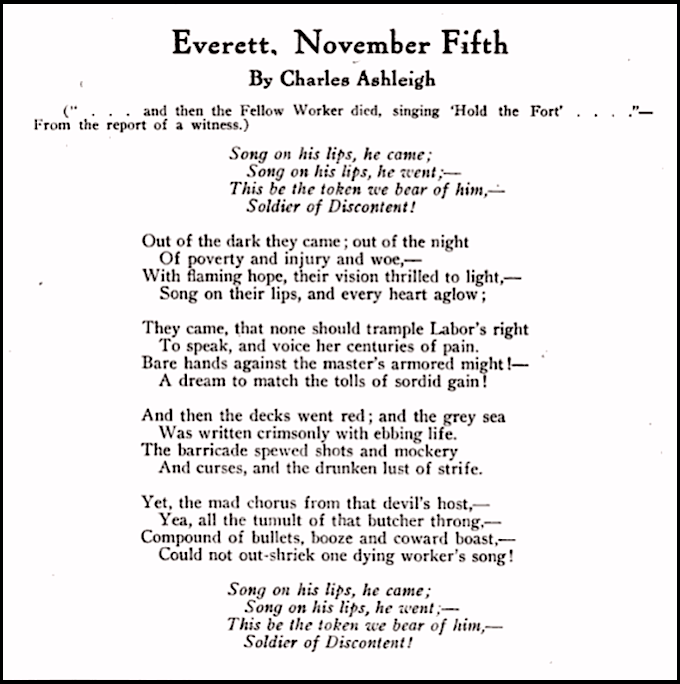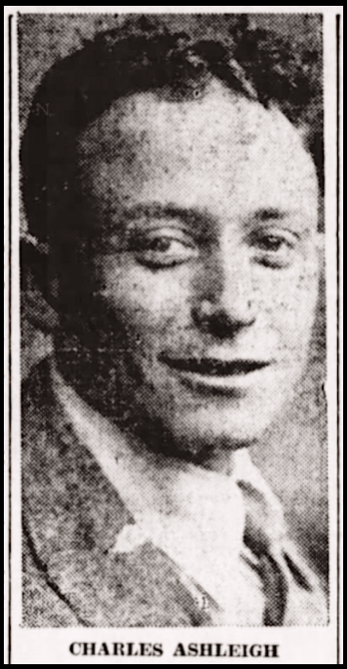They came, that none should trample Labor’s right
To speak, and voice her centuries of pain.
Bare hands against the master’s armored might!-
A dream to match the tolls of sordid gain!
-Charles Ashleigh
Hellraisers Journal, Wednesday April 18, 1917
From The Tacoma Times: An Interview with Charles Ashleigh
POET-TRAMP-JOURNALIST A CLOSE OBSERVER
OF BIG SEATTLE TRIALBy Mabel Abbott
SEATTLE, Wash, April 17.-A poet, a tramp, a newspaper man and an I. W. W. sit each day at the press table in Judge Ronald’s courtroom, where a great class struggle is being fought around the stocky figure of Tom Tracy, I. W. W.
They are Charles Ashleigh.
He is in charge of publicity for the Everett Prisoners’ Defense league, and he is a radical of the radicals; so revolutionary that he even dares to defy the tradition that a revolutionist shall be a sinister and mysterious-looking person.
He is young, small, mild-mannered, and speaks literary English with a fine British accent.
He was born in London. As a boy he was for a time an assistant secretary in the Fabian society of socialists and free-thinkers, and saw and heard Bernard Shaw, H. G. Wells and other famous members.
A little later, he tramped through England with the army of the unemployed, haranguing the crowds and stirring the miners of South Wales to organization.
Loves Adventure.
Ordinary life was tame, naturally, after that, and Ashleigh, went to South America.
In Buenos Ayres he was for a little while in the accounting department of a railway; then he took a contract to string telegraph wires along the right of way.
He had never strung a wire in his life, or seen it done, but he hired a foreman who did know how, assembled a gang of Guarani Indians, and started out.
It was a colorful experience. “The Indians aren’t really a bad sort at all, you know,” Ashleigh explains, “but they do drink. One night the cook shot his brother, in my tent. They were all rioting around so it was hard to tell anything about it, and the authorities got hold of me, as being the handiest person, I suppose, and put me in jail, until the British consul came and cleared things up.”
Takes Long Hike.
After the construction gang episode and an interlude of cow-punching on one of the huge Argentine ranches, Ashleigh returned to Buenos Ayres and “did society” and hotel news for a daily paper. Then, one day being too much like another in this occupation, he decided to walk across South America.
With one companion, an artist, he crossed the continent to Valparaiso, lecturing wherever there was a civilized community large enough to furnish an audience, stopping at the native houses along the road to drink “mate,” climbing the Andes, and chumming with the mush-feared brigands of that region.
“They never once tried to steal anything from me,” he says.
“I told them I was poor myself, and believed in the cause of the poor, and they gave me cigarettes and invited me to sit at their fires.”From Valparaiso he tramped alone through Chile and Peru to Callao, and shipped before the mast on a sailing vessel for Portland.
Studies Vagrancy.
That was in 1912. Since then he has managed to avoid monotony fairly well. He has tramped in many states, studying the vagrancy problem.
[He says:]
I believe in the first place that it was a result of the economic system, and I haven’t changed my mind.
No man would suffer the hardships and humiliation of being a tramp in America, just for the love of the thing. They do it because they can’t help it.
If I were to tell in England how the American police treat a man simply because he comes into a town with no money and looking for work, they’d not believe me. They’d think I was talking about Russia.
When he was not tramping, Ashleigh has lectured on “Tendencies in Modern Literature” in exclusive drawing rooms, translated documents on the Mexican border, studied the new stagecraft and drama with the enthusiasts of the Little Theater in Chicago and the bohemia of Greenwich Village in New York, ridden in freight cars without a penny in his pocket, worked on newspapers in San Francisco, New Orleans and elsewhere, and written poems that have appeared in the “Little Review,” which proves that they are poetry.
He says he has been connected with the I. W. W. ever since he came to America. And now he is grinding out yards of “publicity” for the big fight that is making history in Judge Ronald’s courtroom.
[His description of himself is:]
I’m a very practical revolutionist. I care less even for progress than for change. I think a revolution would be a good thing because we need a change.
Charles Ashleigh is the author of the now-famous poem, “Everett, November Fifth, republished here from the International Socialist Review of February 1917:

SOURCES
The Tacoma Times
(Tacoma, Washington)
-Apr 17, 1917
(Also source for photo of Charles Ashleigh.)
https://www.newspapers.com/image/68089175/
The International Socialist Review, Volume 17
(Chicago, Illinois)
Charles H. Kerr & Company,
July 1916-June 1917
https://books.google.com/books?id=SVRIAAAAYAAJ
ISR February 1917
https://books.google.com/books/reader?id=SVRIAAAAYAAJ&printsec=frontcover&output=reader&source=gbs_atb&pg=GBS.PA455
“Everett, November Fifth” by Charles Ashleigh
(Also source for image of poem.)
https://books.google.com/books/reader?id=SVRIAAAAYAAJ&printsec=frontcover&output=reader&source=gbs_atb&pg=GBS.PA479
See also:
Fabian Society
https://en.wikipedia.org/wiki/Fabian_Society
Tag: Charles Ashleigh
https://weneverforget.org/tag/charles-ashleigh/
For more on Ashleigh’s reporting of Tracy Trial, see:
Industrial Worker of April 7, 1917, pages 1-3:
http://libcom.org/files/Industrial%20Worker%20(April%207,%201917).pdf
The Defense Begins Presentation of Case
With over a hundred witnesses uncalled, prosecution
quits presenting evidence; McRae and other too busy avoiding reference to their brutalities to be satisfactory; Story of contradictions and of prevarication; Spokane evidence a boomerang.By Charles Ashleigh and W. C. Smith
—–
Industrial Worker of April 14, 1917, pages 1 & 3:
http://libcom.org/files/Industrial%20Worker%20(April%2021,%201917).pdf
Story of Savagery Graphically Developed
———-I. W. W.’s, other workers, preachers, lawyers, deputies, employers, Christian Scientists and men and women of Everett, on stand develop story of Employers’ Murder Plot beginning in profit lust, official thuggery and degeneracy and ending in Crowning Massacre of labors annals, “Bloody Sunday”; story proves the absolute necessity of Industrial Revolution.
By CHARLES ASHLEIGH.
—–
Industrial Worker of May 1, 1917, pages 1 & 5:
http://libcom.org/files/Industrial%20Worker%20(May%201,%201917).pdf
Conspiracy Bubble Punctured
———-As Trials Draw to Close More Emphatic Grows Each Day’s Revelations of Development of Premeditated Murder-Plot; First Shot Fired from Near McRae; Deputies Shot at Drowning Workers; Further Proofs of Perjury by Ex-Sheriff; Facts Developed by Cross Examination Even More Damning Than Direct Evidence.
By CHARLES ASHLEIGH

